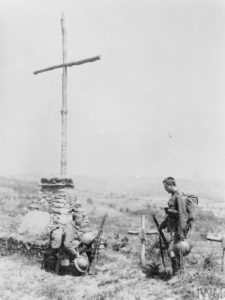Sunday May 19th, 1918
Stand to 4:30. Breakfast 6am. Work 7 – 11. Finished for day. Terrible hot day. Visited British Military Cemetery. Very sorry for loved ones far away from them. Not feeling well – old complaint. Got down soon.
Cemetery Visit

It is unclear which cemetery Frank visits today. The largest cemetery around would have been what is now known as the Dorian Military Cemetery near the south-east shore of Lake Dorian. At the time, it was the Colonial Hill Cemetery No.2 which was created in late 1916 for the dead of the Doiran front. In early 1918 the graves would have been mostly those of officers and men of the 22nd and 26th Divisions who were killed during the fighting of April and May 1917 around Petit-Couronne. Later will be added the graves of those killed in the fighting of 18-19 September 1918. These attacks on Pip Ridge and the Grand-Couronne¹ are part of the final push that lead to the Allies’ victory on the Macedonian Front.
However, to visit Colonial Hill Cemetery No. 2 would have been a long journey for Frank to make. So it is more likely that he visited a temporary cemetery that was later consolidated into that at Dorian. The photograph shows two British soldiers in Salonika paying homage at a comrade’s grave before leaving the front line.*
Graves Registration Unit
‘In all conflicts in which the British army had been involved prior to the Great War, little attention had been paid to the remains of the other ranks, which were generally buried in unmarked mass graves.’²
This changed during WWI for a variety of reasons. Partly, it was a hangover from the Victorian obsession with memorializing the dead. Much more, it was the authorities realizing how important respectful treatment of the dead was to the morale of both the troops and those on the home front. In the face of such unprecedented loss, knowing for certain what had happened to loved ones (see post on Jack Kipling) and where their resting places were, became vital for the continued prosecution of the war itself. It also became important to treat officers and other ranks equally in death.
Ill prepared at the beginning of the war, the role of identifying the dead and their ad hoc burial sites fell to the Red Cross. By March 1915, the newly created Graves Registration Unit took over this role. However burial of the dead remained the responsibility of the Army units. Organizationally and emotionally this was difficult as brothers and friends had to identify and bury their own, and then go back into combat. Over time this led to the creation of Divisional and Corps Burial Officers, but the work continued to take a heavy toll.²
Killer Hill
Lt. Victor Borgonon describes his experience of burying the dead in Salonika in September 1918. ‘Arriving at 12th Corps H.Q. we received our orders to proceed to Killer? Hill to bury the dead.
Now I would like to pass quickly over the gruesome details, but just mention that our men had to work with their gas helmets on all the time, that two of our men died, two went off their heads, and thirty four went into hospital, it will convey a slight idea of the sacrifice entailed in paying the last respects to the lads who had given their lives to King & Country.
We buried over 300 British whilst with the Greeks, French & Bulgars we totalled over 620. Just a plain stick with what particulars we could gather marked their last resting place.’³
13th (Service) Battalion War Diary – 19th May 1918 – Sporan
Our artillery was mostly quiet. Enemy artillery was more active than usual. He fired a lot of 77mm shells of all kinds into most camps in the sector. The ?? on Claymore was knocked out and three men were wounded.
Our aircraft were fairly active but no enemy planes were seen. Patrols saw and heard nothing of the enemy. The undergrowth about Dautli is now at least 6 feet hight and is infested with mosquitoes. Enemy observation balloon was up between 18:50 hrs and 19:20 hrs NW of Trapeze de Pobreg. The moving light of train has been seen at 21:15 hrs the last two nights behind Trapeze de Stojarovd from OP on Glengarry. Second day of Divisional Sports. The Battalion was second in the Tug of War and was second in the ‘Boat Race’ in the Gymkhana event.
References & Further Reading
¹ ‘Dorian Cemetery‘ from Commonwealth War Graves Commission
* Q64257, copyright Imperial War Museums
² ‘Clearing the Dead‘ by Peter E Hodgkinson
³ Diary of Lt Victor Edward Borgonon (1882-1966)


